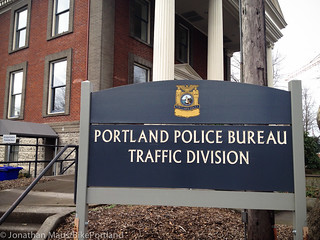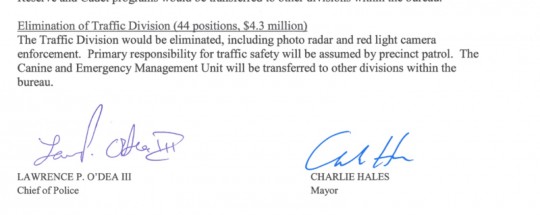Local media coverage of the Portland Police Bureau’s 2016-2017 budget proposal has sent shockwaves through the community. But there’s no reason for alarm. Here’s what’s going on…
Back in November, Mayor Charlie Hales asked all bureau directors to cut 5 percent from their budgets. Despite the City enjoying “relative fiscal stability,” the Mayor said the cuts are necessary to address the affordable housing and homelessness crisis. This is how it goes every budget cycle: The Mayor issues “budget guidance,” then the directors send him proposals with that guidance in mind.
The police bureau’s budget has raised eyebrows because, in his budget that was made public yesterday (PDF here), Chief Larry O’Dea proposed the elimination of three speciality units that have a major impact on all our lives. One of those units, the Traffic Division, writes over 90 percent of all traffic citations and is responsible for keeping our streets safe and sane. The elimination of the Traffic Division would cut 44 positions and would save the City $4.3 million in the fiscal year.
Here’s more from the police bureau’s budget request about the impact this cut would have (emphases mine):
The Traffic Division would be eliminated, including the photo radar and red light camera enforcement programs. Primary responsibility for traffic safety will be assumed by precinct patrol. The Canine and Emergency Management Unit will be transferred to other divisions within the bureau.
The elimination of this specialty unit will have several negative impacts on the bureau’s capabilities. The division performs focused, high-visibility and grant-funded traffic safety enforcement missions that would not otherwise be performed. The Traffic Division issues roughly 80,000 traffic citations each year, which is 94% of all Portland traffic citations, which would not otherwise be issued. Traffic officers are the primary responders to DUII cases, and their targeted missions interdict roughly 80% of DUII offenders that would not otherwise be stopped. Their familiarity with the complex on-scene process involved with DUII stops makes them substantially more efficient than most patrol officers. Roughly 4,700 additional hours of precinct officer time would be spent processing the 20% of remaining DUII cases. The major crash investigations team would become a detached assignment of officers assigned to regular duties in core functions. The sworn staff positions required to issue citations of the red light camera program and photo radar speed enforcement program would be eliminated and those programs discontinued and more than 38,000 annual citations would no longer be issued. Motorcycle officers would be dispersed to precinct patrol duties. Coordination and availability of their operation for dignitary protection and special events would be significantly reduced. Grant funding for traffic safety enforcement would no longer be available because it is predicated on the bureau having a dedicated traffic safety division. Because of the elimination of the focused patrol and enforcement provided by the Traffic Division, the impacts of cutting the division is anticipated to increase the number of traffic collisions, number of driving while impaired and/or distracted, and number of traffic accident fatalities. The bureau was already anticipating negative impacts on traffic safety resulting from the legalization of marijuana in the State of Oregon based on the State of Colorado’s experience with recreational marijuana legalization. In Colorado, in the first year that retail marijuana was legalized, there was a 32% increase in marijuana-related traffic deaths, and marijuana-related traffic deaths increased from 10% to 20% of all traffic deaths. There has already been one marijuana-related traffic death in Portland in 2016.
Advertisement
The police bureau’s Bureau Advisory Committee said the negative impact of this and other services in the five percent cut package, “is too extreme especially to services provided to the community and vulnerable populations in the areas of domestic violence, traffic safety and school safety.”
“Because we’re already so lean, we don’t have any good places to cut anything.”
— Larry O’Dea, Portland Police Chief
The thought of eliminating the Traffic Division is very worrisome to say the least — especially as Portland gets serious about Vision Zero. But the good news is it’s just a thought. We can all but assure you it won’t be cut. This is all about process and a bit of politics.
When I saw the proposal I asked Police Chief Larry O’Dea (a former captain of the Traffic Division) to help us understand what’s going on.
“We are not anticipating any cuts,” he said. According to Chief O’Dea, his bureau is simply going through the budget exercise so the Mayor can see how a five percent cut will look. And at the police bureau, those cuts look so horrible they are very unlikely. “Because we’re already so lean, we don’t have any good places to cut anything,” O’Dea continued. “This cut would mean all our specialized functions short of gang enforcement.”
Not only does O’Dea say the police bureau will be spared any budget cuts, he says they’re anticipating gaining a few new positions. He mentioned needing more officers to meet their commitment to Vision Zero, restoring a night shift officer and bulking up their response to “marijuana-related driving.”
While Mayor Hales is sticking to his process and requiring all bureaus to take part in this budget cut proposal exercise, he has already hinted that core city functions like these police services won’t be on the chopping block. In his November memo, Hales said, “I will look to preserve core public safety functions… I will continue to ensure that City resources are allocated to programs that have a direct impact on the lives of our citizens and that we focus on maintaining our assets and infrastructure.”
This is all a good reminder to stay engaged with the budget process (it’s also reminder of how important the police budget is!). Stay tuned for public hearings on April 5th and 12th where you can share your feedback with the Mayor. The final budget adoption at City Council is set for June 9th. Learn more about how the City budget works at the Budget Office website.
— Jonathan Maus, (503) 706-8804 – jonathan@bikeportland.org
BikePortland can’t survive without paid subscribers. Please sign up today.



